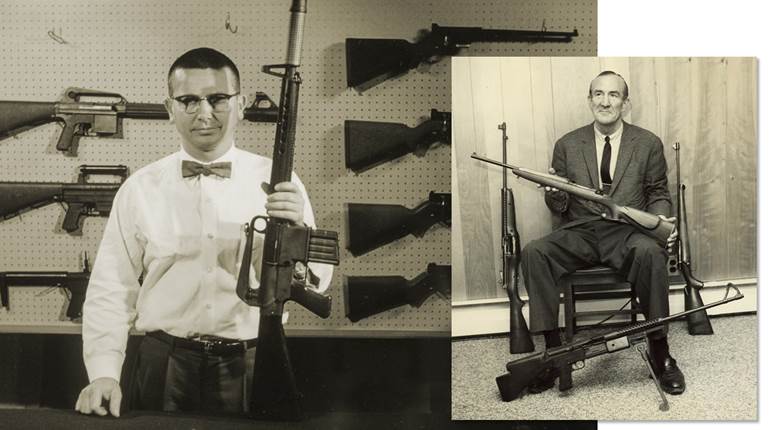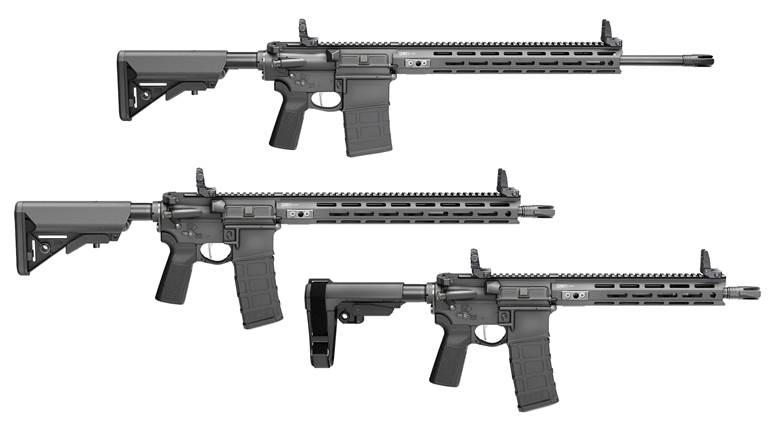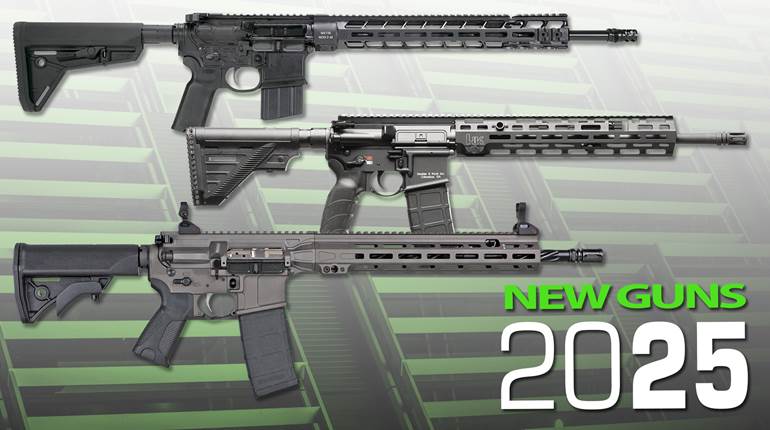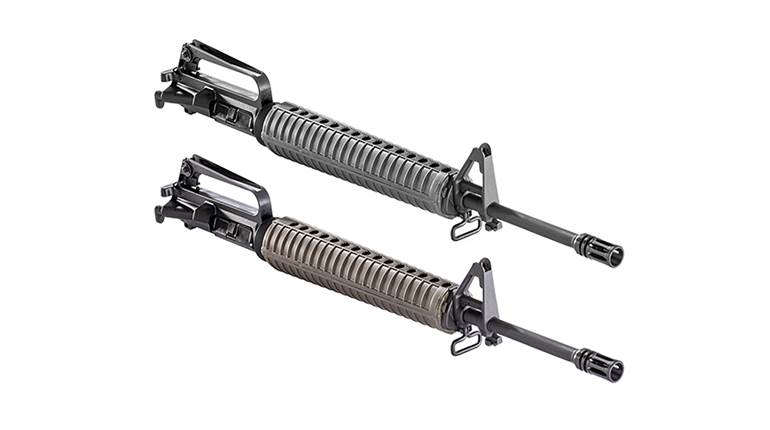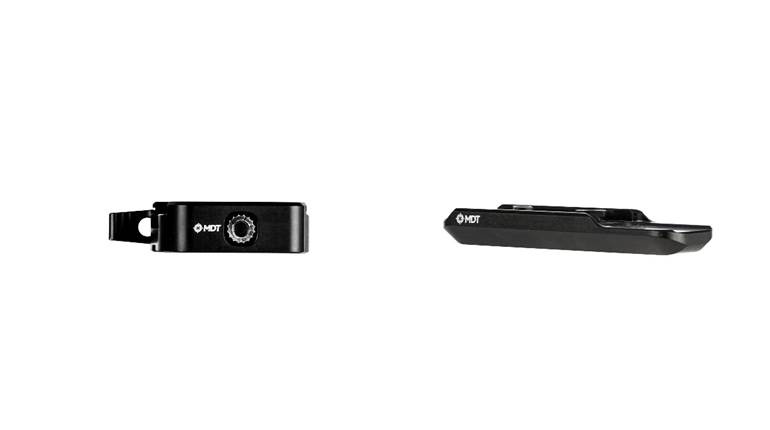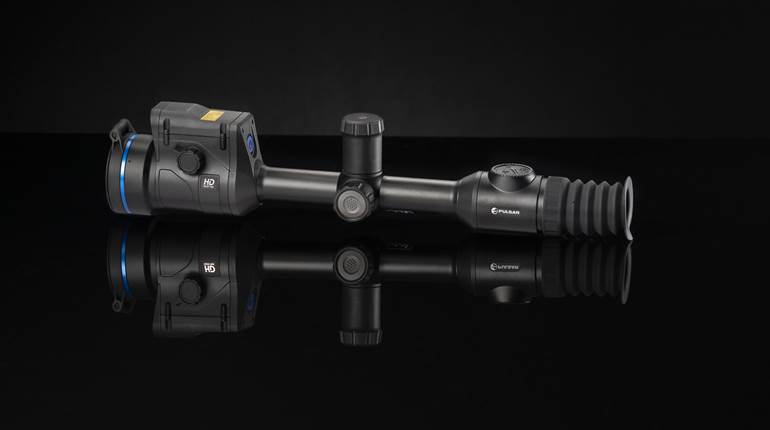
In total, fewer than 10,000 original AR-10s were produced, but despite production ceasing in 1961, Eugene Stoner’s lightweight battle rifle had a profound impact on the world of small arms design. Development of what became the AR-10 began in the early 1950s, and it would eventually bring together four key ingredients: the use of cutting-edge lightweight materials; a direct impingement gas system, which helped reduce weight; an in-line layout, which mitigated muzzle climb; and the use of a rotating, multi-lug bolt. These fundamental elements have continued to characterize the AR-10 and the AR-15/M16 family that it spawned.
While the AR-15/M16 family of rifles have for decades dominated the American military and civilian firearms market, the ubiquitous AR-15 owes its development to its 7.62x51mm predecessor. The AR-10, as the foundation on which the AR family was built, has a special place in small arms history.
For decades this historic legacy has captured the imaginations of generations of shooting enthusiasts and recently there has been renewed interest in the AR-10 as Brownell’s launch its retro reproduction, the BRN-10. Based largely on the Sudanese contract AR-10s of the late 1950s, the BRN-10 is not identical, but it offers an accessible opportunity to own and shoot the iconic rifle, albeit one that has some external and internal differences.
Can the Aircraft Industry Make a Rifle?
The AR-10’s story begins in 1952, when George Sullivan and Charles Dorchester, a patent attorney and an engineer with a background in the aircraft industry set up a new company, S-F Projects, to develop their lightweight Para Sniper Rifle. Two years later in October 1954, S-F Projects was acquired by Richard Boutelle, President of the Fairchild Engine and Aircraft Corporation, and the company was subsequently renamed ArmaLite and operated as a subsidiary of the aircraft company for the next eight years.
Stoner Joins ArmaLite
Enter Eugene Morrison Stoner, a former U.S. Marine Corps armorer from Indiana. With no formal engineering qualifications, Stoner had entered the aircraft engineering industry in the late 1930s before joining the Corps, becoming an ordnance officer. Since leaving the service and moving to California, Stoner had been working on a series of his own designs, and submitted several for U.S. Ordnance Corps testing. It was a chance meeting at a gun range with George Sullivan that led to Stoner joining ArmaLite.
Stoner joining ArmaLite coincided with his development of what he called the M-8, an “autorifle” that subsequently became known as the X-01, chambered in .30-06, not the new .308 T65 round then in development. This was Stoner’s first step toward the AR-10. While the X-01 differed massively from the later AR-10s, it featured the in-line profile, rotating bolt and direct gas impingement system which would remain fundamental throughout the development of Stoner’s Rifle. The X-01 was made from stamped steel and had wooden furniture, not the forged aluminium and plastic composite that later rifles would make use of, but despite this it still weighed just under 8 lbs., respectable for a .30-06 rifle, and substantially lighter than an M1 Garand. (right: Designer Eugene Stoner poses in front of his early prototypes at ArmaLite’s offices (GUNS magazine, March 1957)
Over the next three years ArmaLite’s engineers would take Stoner’s X-01 and create a revolutionary, lightweight battle rifle that would compete with the iconic FN FAL, the U.S. government’s M14 and the German G3. The subsequent X-02 and X-03 prototypes saw Stoner’s design move away from the boxy, basic stamped steel design towards a more ergonomic rifle with space age fibreglass and polymer furniture, developed by ArmaLite’s Tom Tellefson, and a forged Aluminium receiver spearheaded by George Sullivan. The X-02 was also the first AR-10 prototype to be chambered in the new 7.62x51mm T65 round and the X-03 introduced the instantly recognisable forged carrying handle which would become standard on future AR-10s and the later AR-15/M16 family.

One of the earliest Hollywood AR10s SN #100. Note the early muzzle device (Institute of Military Technology Collection. Photo: Michael Fullana)
The X-03 was rechristened the AR-10A, as ArmaLite pushed to create the most capable, lightweight battle rifle they could. The AR-10A had forged aluminium upper and lower receivers, which made the rifle expensive to produce but lighter and stronger. At this point the rifle still had a right-side charging handle and a gas tube that ran along the side of the barrel, rather than above it. ArmaLite also began to experiment with their first muzzle devices in the mid-50s, and in 1956, Stoner patented the aluminium “waffle” magazines (US #2,903,809) that would come to be used by future production AR-10s. In August 1956, Stoner patented his direct impingement and rotating bolt and carrier concept, with the patent (US #2,951,424) being granted later in 1960. The beauty of the direct impingement system was that it lightened the rifle, removing the need for a more traditional piston-operated gas system, with heavy parts like an operating rod no longer needed.

Springfield Armory file photograph of the AR-10B disassembled, taken during evaluations in 1956. (Springfield Armory)
U.S. Army Interest
In March 1956, the U.S. Army Ordnance Corps made ArmaLite and Fairchild an unexpected offer. Following the unveiling of the AR-10A, and the publicity that surrounded it, the Ordnance Corps sought to acquire the development and production rights to the AR-10 with ArmaLite set to gain royalties for each rifle built. ArmaLite, however, declined the offer fearing the Army would use this as a way to bury and abandon the AR-10. As Joseph Putnam Evans suggests in his book, The ArmaLite AR-10, this likely contributed to the Ordnance Corps’ subsequent resentment towards ArmaLite.
The AR-10’s design was improved incrementally with testing and government requests and requirements most frequently driving development. The next step toward a production gun, the AR-10B, emerged in April 1956. This saw the introduction of the now ubiquitous pivoting, two-pin, upper and lower receiver layout with a separate buffer assembly in the butt. The charging handle was also moved to the top of the receiver, inside the carrying handle, and was no longer reciprocating as in earlier prototypes. Perhaps most disastrously the new AR-10B used a steel and aluminium composite barrel, used in the earlier S-F Projects Para Sniper, which Stoner feared would separate, impair accuracy and potentially burst under rapid fire.

A photograph from the Springfield Armory trials showing the burst composite barrel of SN #1002. (Springfield Armory)
In late 1956, the Springfield Armory tested the AR-10B as part of the Army’s Lightweight Rifle Program. A combination of ArmaLite’s weight-saving measures and the Ordnance Corps’ resentment of the rifle spelled disaster. During an endurance test one of the test rifles suffered a failure of the rifle’s compensator and the heat from high rates of fire warped the gas tube. During a later test in February 1957, the composite barrel of one of the test rifles failed during a round of harsh endurance testing. The rifle, No.1002, had fired 5,564 rounds during the testing program. The composite failure caused the barrel to burst in the middle of the handguard, the rifle’s operator was not injured. Despite ArmaLite engineers rapidly fabricating a replacement all-steel barrel and the testing being resumed just a week later, the axe had fallen for the AR-10. Springfield Armory reported that ArmaLite’s rifle was “not satisfactory as a military rifle” with their final report, published in February 1957, stating the rifle was not safe and suffered from a series of faults. In 1958, the M14 was adopted by the U.S. Army, with the first rifles reaching troops in the summer of 1959. They would not see action until U.S. interventions in Vietnam and the Dominican Civil War, in 1965, alongside the AR-10’s 5.56x45mm descendent, the M16.

The prototype AR-15, developed in 1957 by Robert Fremont and L. James Sullivan, the XAR-15 was the beginning of the extremely successful AR-15 dynasty (Institute of Military Technology Collection. Photo: Michael Fullana).
The First AR-15
Despite the disaster during testing at Springfield Armory and the Ordnance Corps’ subsequent rejection of the AR-10, ArmaLite still had its supporters within the U.S. military. General Willard Wyman, the influential commander of the Continental Army Command, took a keen interest in the design and provided the catalyst for ArmaLite’s experiments to rechamber their rifle in a small calibre, high-velocity round. Stoner saw little potential in the small .222 Remington round the Army wanted to test. As a result, two other ArmaLite engineers, Robert Fremont and L. James Sullivan, began developing a version of the AR-10 that could fire a .22 caliber round. The result was the XAR-1501, ready for testing in 1957. As Stoner had predicted, however, the new small round was found lacking in penetration. With some help from Stoner, the .222 Remington round evolved into what became known as .223 Remington, later standardized by NATO as 5.56x45mm. The XAR-15 prototypes retained the AR-10’s in-line layout, direct gas impingement system and rotating bolt as well as its use of modern materials. At this point the Army’s new M14 was just months old but Wyman and the Army’s Infantry Board were impressed and requested that ArmaLite continue to develop the XAR-15. The XAR-15 would eventually become the AR-15, but the AR-15’s future would, however, lay in another company’s hands.
The Dutch Connection
ArmaLite was a small research and development company, not a major manufacturer and, in 1956, had a very small workforce of around a dozen. As a result in June 1957, Fairchild, ArmaLite’s parent company, sold a production license to the Dutch small arms manufacturer Artillerie Inrichtingen (A.I.). Not only did A.I. claim to have the capacity needed to mass produce the AR-10 to fulfill the contracts ArmaLite’s salesmen secured but they also opened the way into the promising untapped market of the European NATO powers. So as ArmaLite increasingly turned their attention to the new XAR-15, the AR-10 torch was passed to the company’s new Dutch partners.

A "transitional" variant of the AR-10 which incorporates some features seen in the later Portuguese model, such as the shortened fore-end, however, unlike the later Portuguese rifles this example does not have an adjustable gas block (Rock Island Auctions).
Fairchild/ArmaLite employed a number of salesmen to market the AR-10 and the company’s other offerings around the world. These included the legendary Sam Cummings of InterArmsCo, Jacques Michault of SIDEM International and Bobby MacDonald of Cooper-MacDonald, a Baltimore-based company that had handled Colt and Remington’s sales in the Far East in the past. These three principals divided up the world amongst them and embarked on a substantial sales tour demonstrating the new AR-10 wherever they could. This strategy began to pay off with small orders placed from a number of countries for testing.
The AR-10 was evaluated by a number of countries where it was narrowly beaten by its competitors, including: West Germany (by the G3), in Austria (by the FN FAL), in the Netherlands (again by the FAL), by Beretta’s BM-59 in Italy, and in Finland where despite being rechambered to the Soviet 7.62x39mm round it was beaten by an AK-47 clone. The reason for ArmaLite and A.I.’s inability to capture these contracts vary from country to country but reasons include cost and some quality control issues but most commonly the AR-10 was the victim of political and bureaucratic wrangling both abroad and in the Netherlands.
Some success was seen with small orders to a number of countries around the world. Recently unearthed documents from A.I., held by the Netherlands Military Museum, show that among others Cuba ordered 51 rifles (before Fidel Castro’s coup), the Netherlands purchased over 250, Burma ordered 200, India and Austria purchased more than 30 each for testing. West Germany bought nearly 150 for testing and 450 were also sold to Guatemala. Italy had initially purchased several rifles for evaluation but in early 1962, as A.I. production was coming to an end, the Italian COMSUBIM, Italy’s elite commando frogman unit, having earlier purchased an estimated 500 rifles, snapped up the 60 last remaining AR-10s in the factory. As such the COMSUBIM were A.I.’s very last customers.
By far the largest orders, however, were made by Sudan and Portugal. Sales to the Sudanese represented the AR-10’s first major sale. In 1958, the Sudanese Army had initially looked to replace their bolt-action Lee-Enfields with British-made FN FALs but after Sam Cummings demonstrated the AR-10 they immediately ordered the new American rifle. Sudan ordered 2,508 rifles for their defence force’s elite units, a contract worth some $2.8 million. The documents held by the Netherlands Military Museum confirm that these guns were delivered by 1960.
The other major order, from Portugal, is perhaps the best known AR-10 contract. The Portuguese AR-10s saw extensive combat use in post-colonial counter-insurgency conflicts in Angola, Portuguese Guinea and Mozambique. The Portuguese Model 961 was the most evolved AR-10 variant developed by A.I. The elite Cacadores Paraquedistas (airborne light infantry) it was issued to loved it for its relative simplicity, accuracy and effectiveness. Portugal initially ordered 1,555 rifles in 1960 with further substantial orders likely. Before these orders could be placed, the Dutch government intervened and placed an embargo on arms sales to Portugal, this sounded the death knell for A.I., and the AR-10.

A Cacadores Paraquedistas on patrol with his AR-10 at the ready (Guerra Colonial).
By the early 1970s the Paraquedistas’ AR-10s had seen such hard service that spare parts were becoming scarce. Field expedient replacement wooden stocks were common if the original space-age bakelite furniture became damaged. Despite this the Paraquedistas continued to favor the lighter, more controllable and easier to maintain AR-10 over the G3-pattern rifles that increasingly replaced it.
A.I. produced myriad AR-10s some to meet specific requirements from various countries in the hopes of adoption, others were transitional models as general improvements were made while some like the heavy barrel squad support weapon versions were aimed at filling gaps in the market. Despite this prolific development and refinement from 1958 until January 1961, A.I. produced just 5,864 rifles according to the admittedly incomplete documents held by the Netherlands Military Museum. Other estimates suggest that in total just short of 10,000 rifles were produced before production of the first generation of AR-10s ended in 1961.
Fairchild Makes a Deal with Colt
The Fairchild Corporation became increasingly frustrated with both A.I.’s continued production delays and the lack of major sales. In need of funds to support the parent company Fairchild decided to sell Colt the rights to ArmaLite’s AR-10 and AR-15. Bobby MacDonald, who had initially been tasked with selling the AR-10 in the Far East, was now instrumental in facilitating the sale of ArmaLite’s AR-10 and AR-15 intellectual property to Colt. In a deal that would prove to be incredibly lucrative for the then-struggling Colt, Fairchild agreed to the sale of the patent rights for a lump sum of just $75,000 and a 4.5 percent royalty on all future production. The rest is history.
Following the deal in 1959, Colt subsequently decided to focus its energies on the smaller, lighter 5.56x45mm AR-15, instead of the AR-10. Fewer than 50 AR-10s were produced in ArmaLite’s Hollywood workshops, and fewer than 10,000 rifles were built all told. The AR-10’s true legacy is its spawning of its smaller caliber successor.
My thanks to the Institute of Military Technology for kindly allowing the inclusion of some photographs of their excellent collection. The Institute of Military Technology asks that if you have any information regarding the early development of ArmaLite's AR-10 they would be interested to hear from you to assist their ongoing research. You can contact them at [email protected].












